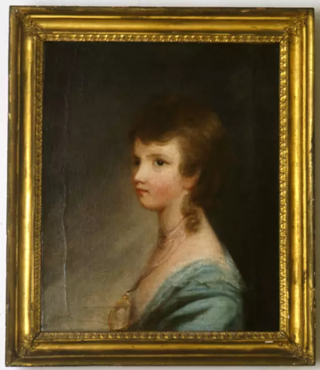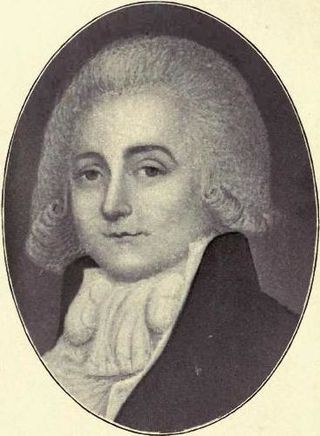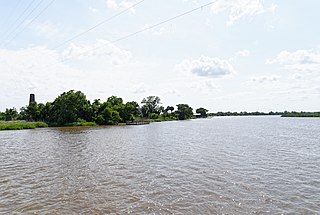
The Act Prohibiting Importation of Slaves of 1807 is a United States federal law that provided that no new slaves were permitted to be imported into the United States. It took effect on January 1, 1808, the earliest date permitted by the United States Constitution.

Georgetown County is a county located in the U.S. state of South Carolina. As of the 2020 census, the population was 63,404. Its county seat is Georgetown. The county was founded in 1769. It is named for George III of the United Kingdom.

Georgetown is the third oldest city in the U.S. state of South Carolina and the county seat of Georgetown County, in the Lowcountry. As of the 2010 census it had a population of 9,163. Located on Winyah Bay at the confluence of the Black, Great Pee Dee, Waccamaw, and Sampit rivers, Georgetown is the second largest seaport in South Carolina, handling over 960,000 tons of materials a year, while Charleston is the largest.

Pierce Butler was an Irish-born American politician who was one of the Founding Fathers of the United States. Born in the Kingdom of Ireland, Butler emigrated to the British North American colonies, where he fought in the American Revolutionary War. After the war, he served as a state legislator and was a member of the Congress of the Confederation. In 1787, he served as a delegate to the 1787 Constitutional Convention, where Butler signed the Constitution of the United States; he was also a member of the United States Senate.
Thomas Spalding was a United States representative from Georgia. He was born in Frederica, Georgia, St. Simons Island, Glynn County, Georgia. He studied law and was admitted to the bar in 1795, but did not practice. He engaged extensively in agricultural pursuits.

The Randolph family of Virginia is a prominent political family, whose members contributed to the politics of Colonial Virginia and Virginia after statehood. They are descended from the Randolphs of Morton Morrell, Warwickshire, England. The first Randolph in America was Edward Fitz Randolph, who settled in Massachusetts in 1630. His nephew, William Randolph, later came to Virginia as an orphan in 1669. He made his home at Turkey Island along the James River. Because of their numerous progeny, William Randolph and his wife, Mary Isham Randolph, have been referred to as "the Adam and Eve of Virginia". The Randolph family was the wealthiest and most powerful family in 18th-century Virginia.

John Hart Crenshaw was an American landowner, salt maker, kidnapper and slave trader, based out of Gallatin County, Illinois.
Peter Hutchins Wood is an American historian and author of Black Majority: Negroes in Colonial South Carolina from 1670 through the Stono Rebellion (1974). It has been described as one of the most influential books on the history of the American South of the past 50 years. He is a professor at Duke University in North Carolina.

St. Thomas Manor (1741) is a historic home and Catholic church complex located near Port Tobacco, Charles County, Maryland. Known as St. Ignatius Church and Cemetery, the manor house complex is the oldest continuously occupied Jesuit residence in the world. The mission settlement of Chapel Point was established in 1641 by Father Andrew White, S.J., an English Jesuit missionary. Father White ministered to the Potapoco Native Americans, some of whom he converted to Catholicism. Established in 1662, this is the oldest continuously active Roman Catholic parish in the American Thirteen Colonies. With the consecration in 1794 of Bishop John Carroll, St. Thomas became the first Roman Catholic see in the United States.

Martha Parke Custis Peter was a granddaughter of Martha Dandridge Washington and a step-granddaughter of George Washington.

John Drayton II was Governor of South Carolina and a United States district judge of the United States District Court for the District of South Carolina.

The Chapel of the Cross is a historic Episcopal church in the Mannsdale area of Madison, Mississippi. The brick structure was built circa 1850–52 by enslaved people. It is noted for its Gothic Revival architecture, which draws heavily from 14th-century English country churches. It was added to the National Register of Historic Places in 1972.

Annandale Plantation was a cotton plantation worked by enslaved laborers in what is now the Mannsdale neighborhood of Madison, Mississippi.

The Great Slave Auction was an auction of enslaved Americans of African descent held at Ten Broeck Race Course, near Savannah, Georgia, United States, on March 2 and 3, 1859. Slaveholder and absentee plantation owner Pierce Mease Butler authorized the sale of approximately 436 men, women, children, and infants to be sold over the course of two days. The sale's proceeds went to satisfy Butler's significant debt, much from gambling. The auction was considered the largest single sale of slaves in U.S. history until the 2022 discovery of an even larger auction of 600 slaves in Charleston, South Carolina.
On June 19, 1838, the Maryland Province of the Society of Jesus agreed to sell 272 slaves to two Louisiana planters, Henry Johnson and Jesse Batey, for $115,000. This sale was the culmination of a contentious and long-running debate among the Maryland Jesuits over whether to keep, sell, or free their slaves, and whether to focus on their rural estates or on their growing urban missions, including their schools.

Butler Island is a 1,600-acre (647.5-hectare) island in the Altamaha River in McIntosh County, Georgia, United States. Part of the Altamaha River Delta, the island is located 1 mi (1.6 km) south-southeast of Darien, Georgia.
William Henry Cain was an American plantation owner and politician; he served as the lieutenant governor of South Carolina from 1846 to 1848.

James Henry Ladson was an American politician, wealthy plantation owner from Charles Town and officer of the American Revolution. He served as the Lieutenant Governor of South Carolina from 1792 to 1794, and was a member of the South Carolina state Senate from 1800 to 1804.
James Henry Ladson (1795–1868) was an American planter and businessman from Charleston, South Carolina. He was the owner of James H. Ladson & Co., a major Charleston firm that was active in the rice and cotton business, and owned over 200 slaves. He was also the Danish Consul in South Carolina, a director of the State Bank and held numerous other business, church and civic offices. James H. Ladson was a strong proponent of slavery and especially the use of religion to maintain discipline among the slaves. He and other members of the Charleston planter and merchant elite played a key role in launching the American Civil War. Among Ladson's descendants is Ursula von der Leyen, who briefly lived under the alias Rose Ladson.